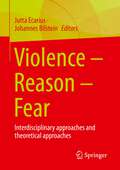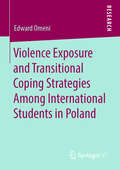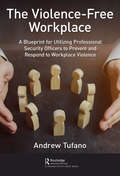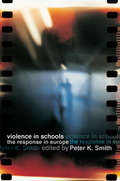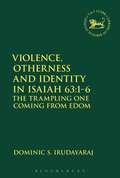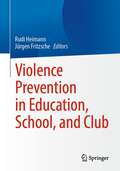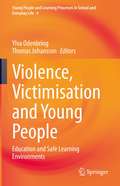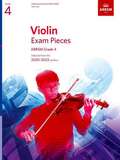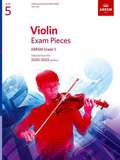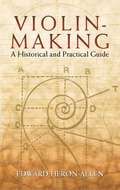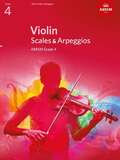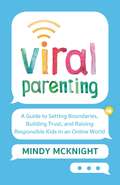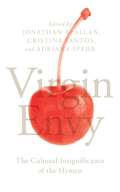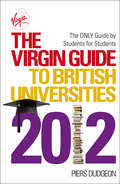- Table View
- List View
Violated: Exposing Rape at Baylor University amid College Football's Sexual Assault Crisis
by Paula Lavigne Mark SchlabachWritten by ESPN investigative reporters Violated narrates the sexual abuse by members of Baylor's football team and the university's attempt to silence the victims. A portion of the proceeds will be donated to RAINN to help fight sexual abuse.Throughout its history, Baylor University has presented itself as something special: As the world's largest Baptist university, it was unabashedly Christian. It condemned any sex outside of marriage, and drinking alcohol was grounds for dismissal. Students weren't even allowed to dance on campus until 1996. During the last several years, however, Baylor officials were hiding a dark secret: Female students were being sexually assaulted at an alarming rate. Baylor administrators did very little to help victims, and their assailants rarely faced discipline for their abhorrent behavior. Finally, after a pair of high-profile criminal cases involving football players, an independent examination of Baylor's handling of allegations of sexual assault led to sweeping changes, including the unprecedented ouster of its president, athletics director, and popular, highly successful football coach. For several years, campuses and sports teams across the country have been plagued with accusations of sexual violence, and they've been criticized for how they responded to the students involved. But Baylor stands out. A culture reigned in which people believed that any type of sex, especially violent non-consensual sex, simply "doesn't happen here." Yet it was happening. Many people within Baylor's leadership knew about it. And they chose not to act. Paula Lavigne and Mark Schlabach weave together the complex - and at times contradictory - narrative of how a university and football program ascending in national prominence came crashing down amidst the stories of woman after woman coming forward describing their assaults, and a university system they found indifferent to their pain.
Violence – Reason – Fear: Interdisciplinary approaches and theoretical approaches
by Jutta Ecarius Johannes BilsteinThe book explores the question of the significance of fear and reason in the context of cultural violence and subjective different experiences of violence. Perspectives from the social sciences, educational philosophy and cultural studies open up an interdisciplinary approach to violence of culture and media, the experience of fear and vulnerability as well as strangeness and rage.
Violence Against Women: Current Theory and Practice in Domestic Abuse, Sexual Violence and Exploitation (Research Highlights in Social Work)
by Alison Phipps Christine Barter Marianne Hester Lorraine Radford Aisha Gill Elizabeth Gilchrist Evan Stark Kirstein Rummery Marsha Scott Nel Whiting Melanie McCarryThis book addresses the issue of domestic violence against women, drawing on research findings, policy developments and current debates to contextualise its alarming prevalence and to propose informed ways of addressing, through training and practice, the needs of both victims and perpetrators in current social and related care provision.
Violence against Women and Children in the Hebrew Bible: Between Trauma and Resilience (The Library of Hebrew Bible/Old Testament Studies)
What did violence against women and children mean for ancient audiences and how do modern audiences hear and process the meaning of violence in the texts of the Hebrew Bible? The rape of Tamar, the sacrifice of Jephthah's daughter, babes ripped from the womb during war-texts such as these are hardly fodder for Sunday School classes; yet we are left with the reality that the Bible is a violent text full of war, murder, genocide, and destruction, often carried out at the behest of God. The essays in this volume explore ways in which the Hebrew Bible uses and abuses women and children to make indelible points concerning the people of Israel, the lived realities of the Israelite society, and God's relationship to His people. Where other works turn to the study of the violence itself, or to the divine nature of violence, this volume focuses in on the human component. As a result, these studies are reminders that women and children born out of trauma are at once vulnerable and valuable, fragile and resilient.
Violence Exposure and Transitional Coping Strategies Among International Students in Poland
by Edward OmeniEdward Omeni draws on concepts from sociology, psychology, and social pedagogical research to examine experiences of violence among international students in Poland. His research study places particular focus on the range of strategies adopted by the students in response to forms of personal and social violence as well as the resulting forms of social exclusion and precariousness. By means of a detailed analysis of narrative accounts, the dynamics of coping with violence are theorized in the situational/social-cultural context of higher education in Poland, where aspects of intercultural relations and identity struggles of ethnic and cultural minorities remain relatively understudied.
The Violence-Free Workplace: A Blueprint for Utilizing Professional Security Officers to Prevent and Respond to Workplace Violence
by Andrew TufanoOrganizations are ethically, morally, and legally required to maintain safe workplaces that protects employees, visitors and anyone who frequents their establishments. But why do organizations that employee uniformed security personnel as part of their overall workplace violence prevention program still struggle to create and maintain the safest possible workplaces? To meet these obligations organizations often employ uniformed security officers to deter, observe, and report criminal behavior, and in some contexts, they physically interact with dangerous individuals to protect employees, consumers and visitors from violent behaviors. Unfortunately, many organizations don’t utilize their security personnel to their fullest potential and organizational and community members continue to be victims of workplace violence. This book identifies the flawed principles, policies and personnel decisions that organizations use, and it provides practical solutions to address them. The book covers two major themes: the misapplication of law enforcement community safety principles to private, free-market businesses and the use of risk aversive philosophies to their security officer’s activities. This book covers the principles, policies and personnel necessary for maximizing the effectiveness of uniformed security personnel to successfully mitigate potential workplace violence and create and maintain safe organizations. There is a strong need for this book since workplace violence prevention has taken on a new focus due to increases in workplace violence incidents and new laws requiring organizations to take a more serious approach to workplace violence prevention. The healthcare and campus markets are most affected by these laws and are under public scrutiny because of their vulnerable populations. These two markets combined employ the most non-contract, propriety private security personnel in the country. Both markets rely on uniform security officers to create and maintain safe communities and play an important role in their respective workplace violence prevention plans.
The Violence-Free Workplace: A Blueprint for Utilizing Professional Security Officers to Prevent and Respond to Workplace Violence
by Andrew TufanoOrganizations are ethically, morally, and legally required to maintain safe workplaces that protects employees, visitors and anyone who frequents their establishments. But why do organizations that employee uniformed security personnel as part of their overall workplace violence prevention program still struggle to create and maintain the safest possible workplaces? To meet these obligations organizations often employ uniformed security officers to deter, observe, and report criminal behavior, and in some contexts, they physically interact with dangerous individuals to protect employees, consumers and visitors from violent behaviors. Unfortunately, many organizations don’t utilize their security personnel to their fullest potential and organizational and community members continue to be victims of workplace violence. This book identifies the flawed principles, policies and personnel decisions that organizations use, and it provides practical solutions to address them. The book covers two major themes: the misapplication of law enforcement community safety principles to private, free-market businesses and the use of risk aversive philosophies to their security officer’s activities. This book covers the principles, policies and personnel necessary for maximizing the effectiveness of uniformed security personnel to successfully mitigate potential workplace violence and create and maintain safe organizations. There is a strong need for this book since workplace violence prevention has taken on a new focus due to increases in workplace violence incidents and new laws requiring organizations to take a more serious approach to workplace violence prevention. The healthcare and campus markets are most affected by these laws and are under public scrutiny because of their vulnerable populations. These two markets combined employ the most non-contract, propriety private security personnel in the country. Both markets rely on uniform security officers to create and maintain safe communities and play an important role in their respective workplace violence prevention plans.
Violence in African Elections: Between Democracy and Big Man Politics (Africa Now)
by Mimmi Söderberg Kovacs Jesper BjarnesenMultiparty elections have become the bellwether by which all democracies are judged, and the spread of these systems across Africa has been widely hailed as a sign of the continent's progress towards stability and prosperity. But such elections bring their own challenges, particularly the often intense internecine violence following disputed results.While the consequences of such violence can be profound, undermining the legitimacy of the democratic process and in some cases plunging countries into civil war or renewed dictatorship, little is known about the causes. By mapping, analysing and comparing instances of election violence in different localities across Africa – including Kenya, Ivory Coast and Uganda – this collection of detailed case studies sheds light on the underlying dynamics and sub-national causes behind electoral conflicts, revealing them to be the result of a complex interplay between democratisation and the older, patronage-based system of 'Big Man' politics.Essential for scholars and policymakers across the social sciences and humanities interested in democratization, peace-keeping and peace studies, Violence in African Elections provides important insights into why some communities prove more prone to electoral violence than others, offering practical suggestions for preventing violence through improved electoral monitoring, voter education, and international assistance.
Violence in African Elections: Between Democracy and Big Man Politics (Africa Now)
by Mimmi Söderberg Kovacs and Jesper BjarnesenMultiparty elections have become the bellwether by which all democracies are judged, and the spread of these systems across Africa has been widely hailed as a sign of the continent's progress towards stability and prosperity. But such elections bring their own challenges, particularly the often intense internecine violence following disputed results.While the consequences of such violence can be profound, undermining the legitimacy of the democratic process and in some cases plunging countries into civil war or renewed dictatorship, little is known about the causes. By mapping, analysing and comparing instances of election violence in different localities across Africa – including Kenya, Ivory Coast and Uganda – this collection of detailed case studies sheds light on the underlying dynamics and sub-national causes behind electoral conflicts, revealing them to be the result of a complex interplay between democratisation and the older, patronage-based system of 'Big Man' politics.Essential for scholars and policymakers across the social sciences and humanities interested in democratization, peace-keeping and peace studies, Violence in African Elections provides important insights into why some communities prove more prone to electoral violence than others, offering practical suggestions for preventing violence through improved electoral monitoring, voter education, and international assistance.
Violence in Schools: The Response in Europe
by Peter K. SmithViolence in schools is a pervasive, highly emotive and, above all, global problem. Bullying and its negative social consequences are of perennial concern, while the media regularly highlights incidences of violent assault - and even murder - occurring within schools. This unique and fascinating text offers a comprehensive overview and analysis of how European nations are tackling this serious issue.Violence in Schools: The Response in Europe, brings together contributions from all EU member states and two associated states. Each chapter begins by clearly outlining the nature of the school violence situation in that country. It then goes on to describe those social policy initiatives and methods of intervention being used to address violence in schools and evaluates the effectiveness of these different strategies. Commentaries from Australia, Israel and the USA and an overview of the book's main themes by eminent psychologist Peter K. Smith complete a truly international and authoritative look at this important - and frequently controversial - subject.This book constitutes an invaluable resource for educational administrators, policymakers and researchers concerned with investigating, and ultimately addressing, the social and psychological causes, manifestations and effects of school violence.
Violence in Schools: The Response in Europe
by Peter K. SmithViolence in schools is a pervasive, highly emotive and, above all, global problem. Bullying and its negative social consequences are of perennial concern, while the media regularly highlights incidences of violent assault - and even murder - occurring within schools. This unique and fascinating text offers a comprehensive overview and analysis of how European nations are tackling this serious issue.Violence in Schools: The Response in Europe, brings together contributions from all EU member states and two associated states. Each chapter begins by clearly outlining the nature of the school violence situation in that country. It then goes on to describe those social policy initiatives and methods of intervention being used to address violence in schools and evaluates the effectiveness of these different strategies. Commentaries from Australia, Israel and the USA and an overview of the book's main themes by eminent psychologist Peter K. Smith complete a truly international and authoritative look at this important - and frequently controversial - subject.This book constitutes an invaluable resource for educational administrators, policymakers and researchers concerned with investigating, and ultimately addressing, the social and psychological causes, manifestations and effects of school violence.
Violence, Otherness and Identity in Isaiah 63: The Trampling One Coming from Edom (The Library of Hebrew Bible/Old Testament Studies #633)
by Dominic S. IrudayarajViolence disturbs. And violent depictions, when encountered in the biblical texts, are all the more disconcerting. Isaiah 63:1-6 is an illustrative instance. The prophetic text presents the "Arriving One" in gory details ('trampling down people'; 'pouring out their lifeblood' v.6). Further, the introductory note that the Arriving One is “coming from Edom” (cf. v.1) may suggest Israel's unrelenting animosity towards Edom. These two themes: the "gory depiction" and "coming from Edom" are addressed in this book.Irudayaraj uses a social identity reading to show how Edom is consistently pictured as Israel's proximate and yet 'other'-ed entity. Approaching Edom as such thus helps situate the animosity within a larger prophetic vision of identity construction in the postexilic Third Isaian context. By adopting an iconographic reading of Isaiah 63:1-6, Irudayaraj shows how the prophetic portrayal of the 'Arriving One' in descriptions where it is clear that the 'Arriving One' is a marginalised identity correlates with the experiences of the "stooped" exiles (cf 51:14). He also demonstrates that the text leaves behind emphatic affirmations ('mighty' and 'splendidly robed' cf. v.1; “alone” cf. v.3), by which the relegated voice of the divine reasserts itself. It is in this divine reassertion that the hope of the Isaian community's reclamation of its own identity rests.
Violence Prevention in Education, School, and Club
by Rudi Heimann Jürgen FritzscheThe safety of children in the context of protection from assault and violence is a basic need of our society. This edited volume provides a concise overview of the social education of children and young people for all those responsible who want to provide the necessary impetus in the context of their professional, voluntary or educational activities and who are interested in how to convey this successfully. The handbook includes a basic and prevention section.
Violence, Victimisation and Young People: Education and Safe Learning Environments (Young People and Learning Processes in School and Everyday Life #4)
by Ylva Odenbring Thomas JohanssonThis edited collection focuses on different aspects of everyday violence, harassment and threats in schools. It presents a number of in-depth studies of everyday life in schools and uses examples and case studies from different countries to fuel a discussion on national differences and similarities. The book discusses a broad range of concepts, findings and issues, under the umbrella of three main themes: 1) Power relations, homosociality and violence; 2) Sexualized violence and schooling; and 3) Everyday racism, segregation and schooling. Specific topics include sexuality policing, bullying, sexting, homophobia, and online rape culture. The school is young people’s central workplace, and therefore of great importance to students’ general feeling of wellbeing, safety and security. However, there is no place where youth are at greater risk of being exposed to harassment and violations than at school and on their way to and from school. Threats are a relatively common experience among school students, but some aspects of these mundane and frequent harassments and violations are not taken seriously and are, therefore, not reported. Harassment and violations often have negative effects on youth and children, and increase their risks of such adverse outcomes as school dropout, drug use, and criminal behaviour. Contemporary research has shown that gender is of great importance to how students handle and report, or do not report, various violent situations. Studies have also revealed how the notions of masculinity and of being a victim can be conflicting identities and affect how students handle situations of threat, violence and harassment. The importance of gender is also particularly evident with regard to sexual harassment. Female students generally report greater exposure to sexual harassment than male students do.
Violin Exam Pieces 2020-2023, ABRSM Grade 4, Violin part
by AbrsmThis book contains nine pieces from ABRSM’s Grade 4 Violin syllabus for 2020–2023, three pieces chosen from each of Lists A, B and C. The pieces have been carefully selected to offer an attractive and varied range of styles, creating a collection that provides an excellent source of repertoire to suit every performer.
Violin Exam Pieces 2020-2023, ABRSM Grade 5: Selected from the 2020-2023 syllabus (ABRSM Violin Exam Pieces 2020-2023)
by AbrsmThis book contains nine pieces from ABRSM’s Grade 5 Violin syllabus for 2020–2023, three pieces chosen from each of Lists A, B and C. The pieces have been carefully selected to offer an attractive and varied range of styles, creating a collection that provides an excellent source of repertoire to suit every performer. The book also contains helpful footnotes and, for those preparing for exams, useful syllabus information. Inspiring recordings of the nine pieces featured in this book, plus piano accompaniment tracks, are available. These can be purchased as part of the "Violin Exam Pieces with CD" package or as audio downloads (see www.abrsmdownloads.org for more details).
Violin-Making: A Historical and Practical Guide
by Edward Heron-AllenThis classic guide offers an accessible initiation into the mysteries of violin-making. Charming in its style and cultivated in its research, it covers every detail of the process, from wood selection to varnish. A fascinating history of the instrument precedes discussions of materials and construction techniques. More than 200 diagrams, engravings, and photographs complement the text.Author Edward Heron-Allen served an apprenticeship with Georges Chanot, a preeminent nineteenth-century violin maker. The knowledge, skill, and experience Heron-Allen acquired in the master's shop are reflected in this book, which was the first to combine the history, theory, and practice of violin-making. Originally published in 1884 as Violin-Making, As It Was and Is: Being a Historical, Theoretical and Practical Treatise on the Science and Art of Violin-Making for the Use of Violin Makers and Players, Amateur and Professional, this volume has enlightened and informed generations of performers and players alike.
Violin Scales & Arpeggios, ABRSM Grade 4 (PDF): from 2012
by AbrsmThis edition contains all the scales and arpeggios required for ABRSM's Grade 4 Violin exam. Includes all Grade 4 scales and arpeggios for the revised syllabus from 2012, with bowing patterns and suggested fingering, along with a helpful introduction including advice on preparing for the exam.
VIP: Voice Impact Profile
by Stephanie Martin Myra LockhartThe "VIP" is a user-friendly, point-in-time assessment tool which provides an 'at a glance' vocal profile for the clinician, voice coach and client. It examines the potential impact of a number of specific factors on the voice: general health; vocal history; vocal health; voice care; vocal status; voice genogram; anxiety and stress; social functioning; vocal demand; and environmental factors, and offers an overview of the theory to support this choice. The questions have been carefully designed to elicit easily-recorded information from the client about a range of factors that are known to affect vocal quality. The tick-box answers then translate into the Vocal Impact Profile, a visual presentation of the areas of greatest impact on voice. In addition to offering a point-in-time profile, the "VIP" may also be used as a template for achieving change in a specific area of vulnerability and provide a robust visual reinforcement of that change over time. It is, therefore, helpful as a therapy-monitoring tool and as an evaluation of client awareness, behavioural change and clinical effectiveness. Self-administered by the client, the questionnaire should take approximately ten to fifteen minutes to complete. The clinician or voice coach enters the responses into the computer programme (supplied on CD-ROM) or transfers them manually on to the hard copy thus offering a clear visual representation of the results. Worked examples of the VIP are included, presenting six clients with very different aetiologies and with a range of vocal problems. These examples clearly demonstrate the value of the Profile and its visual impact. As a clinical tool the "VIP" provides a subjective qualitative measure, which may be used as an adjunct to other assessment procedures. In addition, it provides a concrete method of determining and ordering the factors to be targeted in terms of therapy or voice work. Using the "VIP" should shorten the time necessary for completion of case history in the case of a voice therapy client, and, when used by a voice coach, the profile will identify areas for further discussion. The Profile is not time-sensitive so it may be repeated to evaluate client awareness of vocal change and implementation of agreed strategies. The "VIP" provides the clinician or voice coach with an efficient and effective means of auditing the therapy or coaching process and promotes a holistic partnership model of intervention.
VIP: Voice Impact Profile
by Stephanie Martin Myra LockhartThe "VIP" is a user-friendly, point-in-time assessment tool which provides an 'at a glance' vocal profile for the clinician, voice coach and client. It examines the potential impact of a number of specific factors on the voice: general health; vocal history; vocal health; voice care; vocal status; voice genogram; anxiety and stress; social functioning; vocal demand; and environmental factors, and offers an overview of the theory to support this choice. The questions have been carefully designed to elicit easily-recorded information from the client about a range of factors that are known to affect vocal quality. The tick-box answers then translate into the Vocal Impact Profile, a visual presentation of the areas of greatest impact on voice. In addition to offering a point-in-time profile, the "VIP" may also be used as a template for achieving change in a specific area of vulnerability and provide a robust visual reinforcement of that change over time. It is, therefore, helpful as a therapy-monitoring tool and as an evaluation of client awareness, behavioural change and clinical effectiveness. Self-administered by the client, the questionnaire should take approximately ten to fifteen minutes to complete. The clinician or voice coach enters the responses into the computer programme (supplied on CD-ROM) or transfers them manually on to the hard copy thus offering a clear visual representation of the results. Worked examples of the VIP are included, presenting six clients with very different aetiologies and with a range of vocal problems. These examples clearly demonstrate the value of the Profile and its visual impact. As a clinical tool the "VIP" provides a subjective qualitative measure, which may be used as an adjunct to other assessment procedures. In addition, it provides a concrete method of determining and ordering the factors to be targeted in terms of therapy or voice work. Using the "VIP" should shorten the time necessary for completion of case history in the case of a voice therapy client, and, when used by a voice coach, the profile will identify areas for further discussion. The Profile is not time-sensitive so it may be repeated to evaluate client awareness of vocal change and implementation of agreed strategies. The "VIP" provides the clinician or voice coach with an efficient and effective means of auditing the therapy or coaching process and promotes a holistic partnership model of intervention.
Viral Parenting: A Guide to Setting Boundaries, Building Trust, and Raising Responsible Kids in an Online World
by Mindy McKnightMindy McKnight, YouTube's favorite mom, shares the tools parents need to keep kids safe in their online lives--and shows how to create stronger family relationships as they do. A cross between Jen Hatmaker and Rosalind Wiseman, VIRAL PARENTING is a guide to raising responsible, safe, and communicative kids in the digital world. Mindy shares practical tools for having honest conversations with kids of all ages about privacy, bullying, respectfulness, and family time, while emphasizing the importance of trust and open communication. These strategies are timeless--whether applied to texting, snapping, Facebooking, kiking, or whatever social media platforms await us in the future, this book is ultimately about teaching children about personal responsibility and safety. Mindy shares practical tools for creating family rules for kids of all ages about privacy, bullying, respectfulness, and family time, while emphasizing the importance of trust and open communication. Using family contracts, guided conversations, device checks, and respectful but firm oversight, the McKnights have raised a close knit family and navigated the complexity of being world-wide internet celebrities with grace. McKnight will show any parent of any child or teen how that's done--setting non-negotiable guidelines and offering a savvy perspective toward privacy that audience have been begging for.
Virgin Envy: The Cultural Insignificance of the Hymen (Exquisite Corpse)
by Jonathan A. Allan, Cristina Santos and Adriana SpahrVirginity is of concern here, that is its utter messiness. At once valuable and detrimental, normative and deviant, undesirable and enviable. Virginity and its loss hold tremendous cultural significance. For many, female virginity is still a universally accepted condition, something that is somehow bound to the hymen, whereas male virginity is almost as elusive as the G-spot: we know it's there, it's just we have a harder time finding it.Of course boys are virgins, queers are virgins, some people reclaim their virginities, and others reject virginity from the get go. So what if we agree to forget the hymen all together? Might we start to see the instability of terms like untouched, pure, or innocent? Might we question the act of sex, the very notion of relational sexuality? After all, for many people it is the sexual acts they don't do, or don't want to do, that carry the most abundant emotional clout.Virgin Envy is a collection of essays that look past the vestal virgins and beyond Joan of Arc. From medieval to present-day literature, the output of HBO, Bollywood, and the films of Abdellah Taïa or Derek Jarman to the virginity testing of politically active women in Tahrir Square, the writers here explore the concept of virginity in today's world to show that ultimately virginity is a site around which our most basic beliefs about sexuality are confronted, and from which we can come to understand some of our most basic anxieties, paranoias, fears, and desires.
The Virgin Guide to British Universities 2012
by Piers DudgeonThe Virgin 2012 Guide to British Universities is the only university guide to offer a uniquely students' eye view of what it's like to study at a particular university. As well as hard facts and practical information on every UK university - such as official ratings for teaching, statistics on where graduates end up and employment prospects by subject - the guide is also packed with useful information such as what the social scene is like, how much living costs are likely to be and what the student profile at a particular university is really like. With a comprehensive entry on every UK university, The Virgin Guide to British Universities contains all the information and advice potential undergraduates will need to choose the best university for them.
The Virgin University Survival Guide
by Karla FitzhughUniversity can be a bit of a jungle - student loans, essay deadlines and 'Freshers Week' are just a few hazards. But with the Virgin University Survival Guide you'll never be lost again. This unique university guide provides practical advice on all aspects of university life, including: Getting ready to go - what to take and what to leave behindFreshers Week - what to do and what definitely not to doYour course - studying, coursework and examsHousing, house hunting and dealing with difficult landlordsMoney - everything you need to know about fees, loans and debtHealth and stressCampus crime and safetyWork and careers - when to start thinking about the futureGraduation and beyond - job, gap year or a post-graduate course?And, of course, how to make the most of your new-found social life. After all, it's not all about studying....
Virginia Satir: Foundational Ideas
by Barbara Jo Brothers“Amid these [world] changes is the growing conviction that human beings must evolve a new consciousness that places a high value on being human, that leads toward cooperation, that enables positive conflict resolution, and that recognizes our spiritual foundations. Can we accept as a given that the self of the therapist is an essential factor in the therapeutic process? If this turns out to be true, it will alter our way of teaching therapists as well as treating patients.” (Virginia Satir in The Use of Self in Therapy, The Haworth Press, Inc., 1987Virginia Satir, an internationally renowned educator and master therapist and a pioneer in the field of family therapy, altered the way therapists are taught and patients are treated. This landmark volume focuses on the important contributions that she made to the therapy profession. Written and edited by therapists who trained and worked closely with her, Virginia Satir: Foundational Ideas reflects her most basic ideas about the healing quality of respect for all people and the emphasis on the personal aspects of treatment rather than the technical. It also addresses the necessity of emotional honesty between the therapist and the patient and illustrates these therapists’impact on therapy as it is practiced today.The legacy left by Dr. Satir includes her profound insight into the behavior of human beings and the guidelines for the application of universal principles in such a way as to enhance human growth and unite individuals. Her impact on therapists around the world is apparent upon reading this triumphant volume. Scholars and practitioners address some of the fundamental tenets of therapy as developed by Dr. Satir and explain how they have integrated these basic foundations into their own practices. The highlights of her professional contributions that are discussed in this exhaustive volume include: the basic patterns of communication that are common to all people and the relationship of communication and self-esteem the triad concept and strategies for teaching people to exist in this basic unit of humankind in a healthy way the parts party and how this process for integrating various aspects of a person can be used with couples as well the model for change process and the ways in which it can be used with individuals, couples, and the world family reconstruction and the value of acting out the past with the therapist as guideVirginia Satir: Foundational Ideas is a sharp, clear focus on the person and work of this great master. It is necessary reading for all professionals around the world who seek to better understand the therapy process and the keys to its success.

